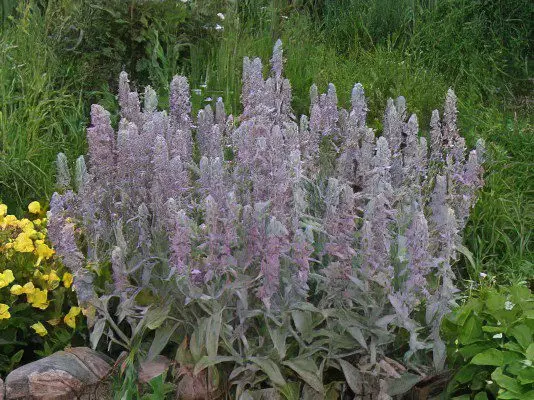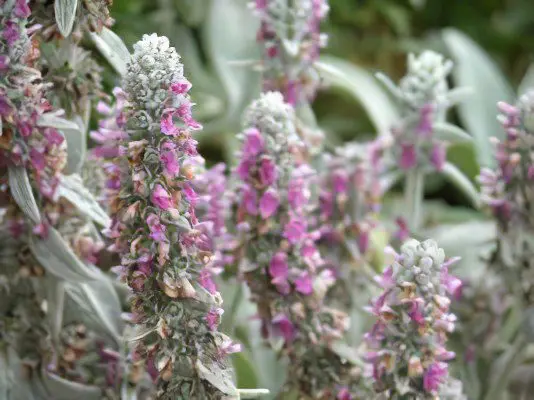Contents
Useful properties and application of cleaner
Description of the cleaner

Chistets belongs to the genus of perennial or annual herbs of the Lamiaceae family. Its height most often does not exceed one meter. The leaves of the plant are toothed, entire, arranged oppositely.
The flowers collected in false whorls have a beautiful purple, lilac, pink, yellow or white color and form spike-shaped inflorescences. The five-toothed calyx with sharp teeth is bell-shaped or tubular-bell-shaped. The fruit is a trihedral oblong or ovoid nut.
Useful properties of cleaner
Many types of chistets have long been used in folk medicine. In particular, infusions of this medicinal herb have been used to facilitate childbirth. It was believed that they were able to anesthetize contractions and speed up the birth process. Official science also did not stand aside, and since the middle of the twentieth century, cleaner preparations have been included in obstetric practice as an effective hemostatic agent.
Chistets boasts a solid set of useful substances and elements. Its various types contain pectin substances, various organic acids, essential oils, carotenoids, tannins, sugars, flavonoids, traces of alkaloids. The presence of vitamin C in the plant has a beneficial effect on the body and helps to strengthen the immune system.
The use of cleaner
For medical purposes, the aerial part of the plant is most often used, which contains the largest number of useful components. Medicinal raw materials are harvested during the flowering period, after which they are dried in the shade in the fresh air or in warm rooms with good ventilation. Traditional medicine recommends infusions of certain types of chistets for fainting, scrofula, diathesis, gout, nervous disorders, and various skin diseases.
Fresh leaves of grass are applied to the affected areas with abscesses, abrasions, bruises, cuts. Some traditional healers use tinctures of chistets to lower blood pressure, increase the strength of heart contractions, eliminate uterine bleeding and menstrual irregularities. It should be noted that, despite many useful properties, preparations of chistets are not included in the list of official medicinal plants in many countries of the world, in particular in Ukraine and Russia.
Chistets flowers

The flowers are small, lilac-pink or lilac, they are collected in dense spike-shaped inflorescences on long pedicels. In folk medicine, the flowers of this medicinal plant are used a little less often than the rest of the aerial part. Most often, decoctions and infusions are prepared on their basis, which help get rid of dandruff, acne and some skin inflammations.
Infusion: to prepare it, it is necessary to pour four tablespoons of chistets grass mixed with flowers with one liter of water, boil for ten minutes in a sealed container, then insist for eight hours, then strain. This remedy should be used externally in the form of lotions, compresses and washings.
Types of cleaner
Chistets has a large number of species distributed almost throughout the globe. Many of them are used to some extent in folk medicine or other areas.
Chistets forest has straight tetrahedral stems, a long creeping rhizome and beautiful dark crimson flowers. This species blooms throughout the summer, bears fruit from July. The forest cleaner grows in Western Asia, China, Europe, the European part of Russia, and Kazakhstan. The plant can often be found in ravines, forests, glades, meadows. This medicinal herb has established itself as a good hemostatic agent. In addition, it has some sedative effect.
Purifier woolly is a fairly popular ornamental perennial plant grown to decorate gardens, lawns and parks. In care, he is quite unpretentious, frost-resistant. The first flowers bloom in early June, the plant blooms for 40-50 days.
Chistets Byzantine is a perennial herbaceous plant. It has branched or straight stems, does not exceed 60 cm in height. This species is widespread in Iran, Turkey, Armenia, and is found in Russia, Ukraine, the Crimea and the Caucasus. This plant is used for both ornamental and medicinal purposes. Byzantine Chistets contains vitamin C, fatty oil and many other elements.
Chistets marsh reaches up to 110 cm in height, has a pubescent stem, stiff, downward-pointing hairs and sharp, finely toothed leaves. The flowers of the plant are painted in a lilac-purple color. This type of cleaner is one of the most used in traditional medicine. Its leaves contribute to the speedy healing of wounds, cuts, abrasions, bruises and abscesses.
Chistets annual grows throughout Europe, in Western Siberia and Central Asia. This plant is a good honey plant. It is not actively used in traditional medicine.
Contraindications to the use of cleaner
Chistets belongs to poisonous plants, therefore, when using it, it is necessary to adhere to the exact dosages and recommendations of a doctor. Self-treatment with this herb is FORBIDDEN! Chistets is also categorically contraindicated during lactation and pregnancy.









